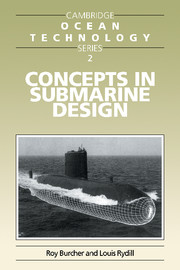Book contents
- Frontmatter
- Contents
- Introduction
- Acknowledgements
- 1 Design in general
- 2 Milestones in submarine history
- 3 Submarine hydrostatics
- 4 The weight/space relationship
- 5 Submarine structures
- 6 Powering of submarines
- 7 Geometric form and arrangements
- 8 Dynamics and control
- 9 Submarine systems
- 10 Considerations of building and costs in design
- 11 Generating a concept design
- Appendix 1 Hydrostatic conditions of flotation
- Appendix 2 Operational practice for keeping in trim
- Appendix 3 Assessing weight and size of variable ballast
- Appendix 4 Submarine pressure hull strength (Prediction of interframe collapse pressures)
- Appendix 5 Estimates of resistance and propulsion
- References and suggested reading
- Index
3 - Submarine hydrostatics
Published online by Cambridge University Press: 05 July 2014
- Frontmatter
- Contents
- Introduction
- Acknowledgements
- 1 Design in general
- 2 Milestones in submarine history
- 3 Submarine hydrostatics
- 4 The weight/space relationship
- 5 Submarine structures
- 6 Powering of submarines
- 7 Geometric form and arrangements
- 8 Dynamics and control
- 9 Submarine systems
- 10 Considerations of building and costs in design
- 11 Generating a concept design
- Appendix 1 Hydrostatic conditions of flotation
- Appendix 2 Operational practice for keeping in trim
- Appendix 3 Assessing weight and size of variable ballast
- Appendix 4 Submarine pressure hull strength (Prediction of interframe collapse pressures)
- Appendix 5 Estimates of resistance and propulsion
- References and suggested reading
- Index
Summary
FIRST PRINCIPLES OF FLOTATION
3.1 To naval architects the hydrostatic properties of vessels floating on the water surface represent a fundamental part of their stock in trade, and that familiarity readily reads across to submarines on the surface; the hydrostatic properties of submerged submarines are less familiar to naval architects in general, but they can identify the parallels without difficulty. For most other engineers the subject of hydrostatics may not be so familiar. For that reason Appendix 1 is provided which gives the broad principles on which the following discussion is based.
The submarine, like any other marine vehicle, has to be designed to float in the water where its weight is supported by the buoyancy forces due to the displacement of water by its hull. For a surface ship the objective is not simply that it should float at the surface but also that it should remain afloat even if some damage resulted in part of the hull being flooded. To cater for this means the provision of a substantial watertight volume of hull above the normal waterline, (Figure 3.1). This enables the surface ship to accommodate changes in weight by adjusting its level of flotation, i.e. by slightly sinking or rising. The amount of sinkage is governed by the area of the hull at the waterline (the Waterplane Area).
As well as just floating, the ship must remain upright in calm water. This involves the consideration of transverse stability and the concept of GM (Metacentric Height) and GZ which, as shown in the Appendix, is also governed by the characteristics of the waterplane area. (Figure 3.2(a)).
Information
- Type
- Chapter
- Information
- Concepts in Submarine Design , pp. 25 - 51Publisher: Cambridge University PressPrint publication year: 1994
